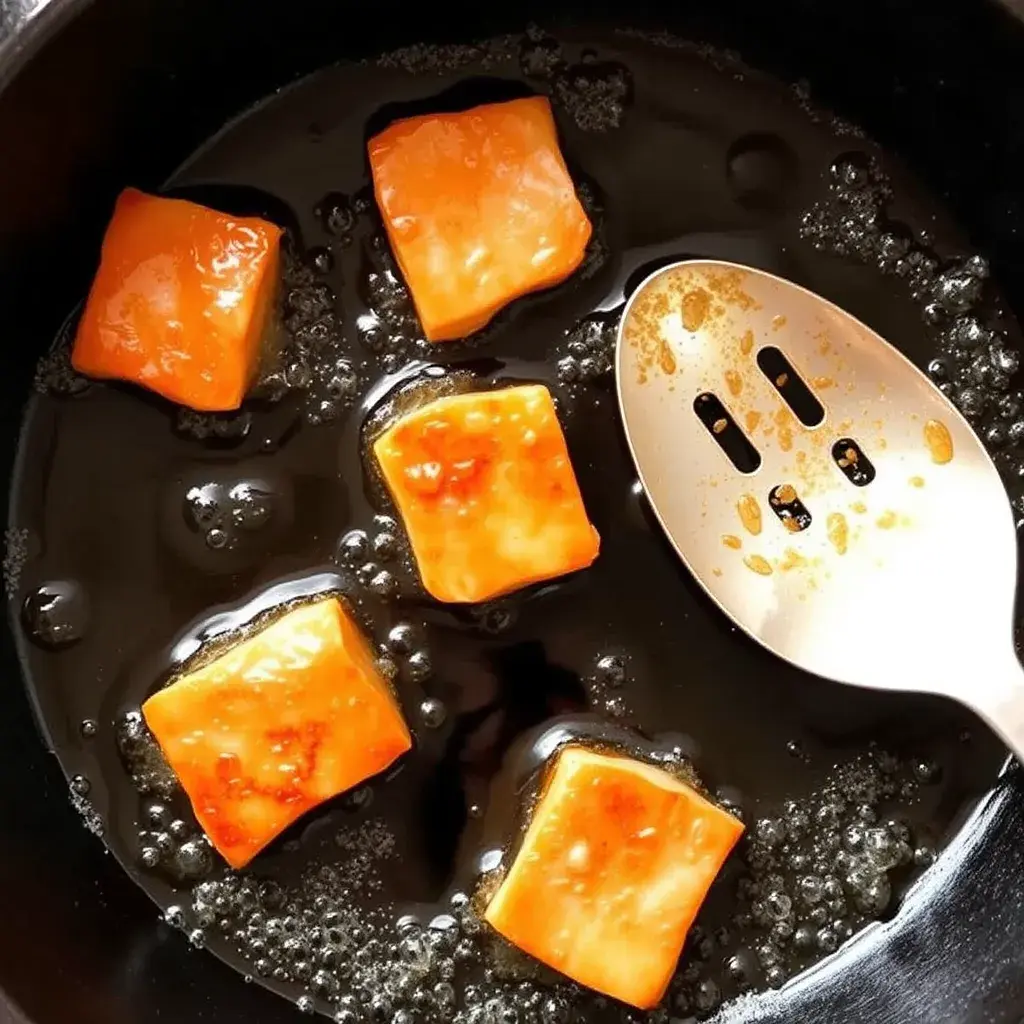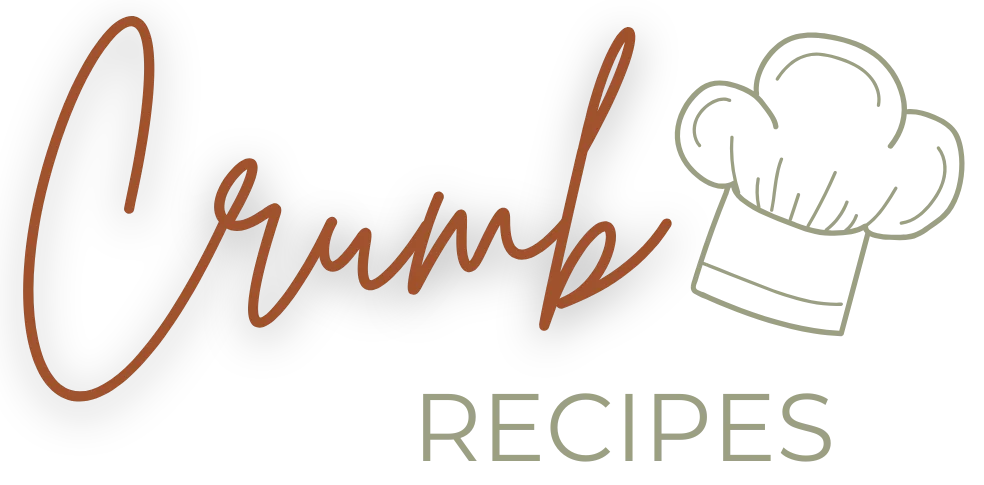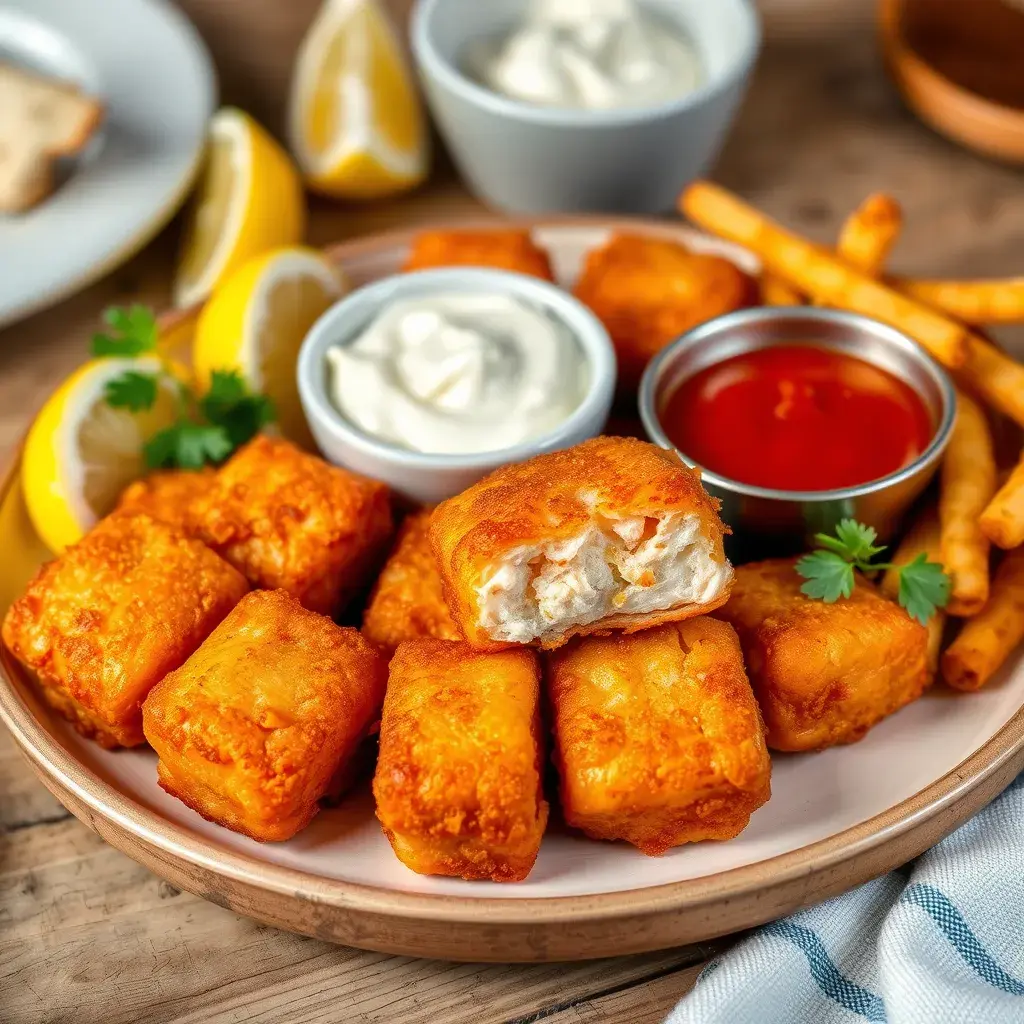1. Introduction
Craving a delicious, crispy seafood snack? Fried salmon bites deliver bold flavors and a satisfying crunch every time. These tasty morsels offer a delightful crunch on the outside and tender fish within. Moreover, they bring a restaurant-quality experience right into your kitchen. Many consider these bites a perfect appetizer, snack, or even a main dish. They are rich in protein, filled with healthy fats, and incredibly versatile. In addition, their cooking process is simpler than you might think.
According to the FDA’s advice about eating fish, and for more recipes featuring salmon, salmon is a safe and nutritious choice. It is a rich source of omega-3 fatty acids and essential nutrients. Additionally, salmon supports heart health and brain function. Healthline’s overview of salmon benefits shows how this fish can support a well-balanced diet. Meanwhile, learning the best techniques to fry it can make all the difference. For an idea of how others prepare crispy salmon, BBC Good Food’s crispy salmon recipe also offers helpful inspiration.
In this article, we will walk through everything you need to know about making fried salmon bites at home. We will cover choosing the right salmon, seasoning, cooking times, and tasty side dishes. Therefore, you can be confident that your next seafood meal will impress friends and family. For more seafood recipes, consider visiting our seafood recipes collection to find other delightful dishes. After reading, you will have a clear path to serving crispy, flavorful salmon chunks that melt in your mouth.
2. Why Fried Salmon Bites Stand Out
2.1 Benefits of Bite-Sized Pieces
Frying salmon in bite-sized pieces creates a treat that is both crisp and delicate. Therefore, it satisfies the palate of even the most selective eaters. In addition, these bites adapt well to many cuisines. You can season them with herbs, spices, or aromatic blends that suit your taste. The small size of these fried salmon bites means they cook quickly, so there is less time in the kitchen and more time enjoying your meal.
This cooking method makes it easy for beginners to enjoy preparing seafood without feeling overwhelmed. By cutting the salmon into uniform pieces, each piece cooks evenly. This approach prevents dry or rubbery textures. In addition, these bites work well for family gatherings, game nights, or fun dinner parties. They are easy to serve and pair with a wide range of sides, making them a flexible choice for any menu.
3. Selecting High-Quality Salmon

3.1 Identifying Fresh Salmon
Good salmon starts with freshness. When shopping, look for firm, vibrant flesh without any dark spots or discoloration. The fish should have a mild ocean scent, not a strong “fishy” odor. If purchasing whole salmon, check that the eyes are clear and the skin appears shiny. These are all indicators of high-quality, fresh salmon. Therefore, look for firm flesh and a pleasant scent. The color should be vibrant and consistent. In addition, avoid pieces with an overly “fishy” smell or slimy texture. When possible, pick wild-caught salmon, as it often has a richer flavor and a healthier nutrient profile. If that is not available, responsibly farmed salmon can also work well.
3.2 Types of Salmon Suitable for Frying
- King Salmon: Rich in flavor and fat, perfect for moist, fried salmon bites.
- Sockeye Salmon: Deep color and bold taste, ideal for those who prefer a stronger flavor.
- Coho Salmon: Mild flavor and medium fat content, great for balanced crispiness and tenderness.
- Atlantic Salmon: Widely available, mild taste, and suitable for most budgets.
3.3 Checking Salmon for Quality
- Color: Should be bright pink, orange, or red depending on variety.
- Texture: Flesh must be firm, not mushy.
- Smell: A clean ocean scent, no foul odors.
- Packaging: If pre-packaged, check the sell-by date and any signs of freezer burn.
4. Proper Seasoning and Marinades
4.1 The Importance of Seasoning
Before frying, season your fried salmon bites to give them character. Seasoning matters because it adds flavor layers and can help form a crispy exterior. In addition, a marinade can penetrate the fish, creating deeper taste profiles. Although simple salt and pepper work, do not shy away from bolder spices like paprika, garlic powder, or a dash of cayenne.
4.2 Classic Marinade Options
A classic marinade often includes a blend of acid, fat, and aromatics. For example, use lemon juice, olive oil, and fresh herbs. Therefore, the salmon’s natural richness gets balanced by bright, tangy notes. In addition, a soy sauce-based marinade adds savory depth. A simple combination might include:
- Lemon juice or lime juice for acidity.
- Olive oil for moisture.
- Garlic, ginger, or shallots for aroma.
- Fresh herbs like dill or parsley for freshness.
- Salt and pepper for a basic flavor boost.
Marinate the salmon for 20-30 minutes in the refrigerator. This short time helps the flavors sink in without making the fish mushy.
4.3 Creative Flavor Twists
If you prefer something more adventurous, consider adding a hint of spice or sweetness. For instance, a honey-soy glaze can caramelize during frying. Therefore, the bites develop a sweet-savory crust. In addition, a spicy chili marinade brings heat that pairs well with creamy dipping sauces. Another idea involves using miso paste for an umami-rich depth. Whatever you choose, always taste before frying to confirm that the flavor suits your preference.
5. Prepping Your Kitchen for Frying
5.1 Tools You Need
- Knife and Cutting Board: For cutting salmon into uniform chunks.
- Mixing Bowls: For seasoning, marinating, and coating.
- Paper Towels/Wire Rack: To drain excess oil.
- Slotted Spoon or Spider Strainer: For removing bites from hot oil.
- Tongs: Useful for flipping or adjusting bites if pan-frying.
5.2 Safety Tips in the Kitchen
When dealing with hot oil, safety matters. Keep a close watch and never leave the stove unattended. In addition, select a stable pan with high sides to reduce splatter. Use long-handled tools to keep hands clear of hot oil. Keep a lid nearby in case you need to smother a small flame. Moreover, work in batches rather than overcrowding the pan. Doing so prevents sudden temperature drops and oil spills.
6. Step-by-Step: Cooking Fried Salmon Bites
6.1 Preheating and Oil Selection
Select a neutral oil with a high smoke point, like canola or peanut oil. This helps prevent the oil from burning too quickly. In addition, preheat the oil to about 350°F (177°C). Use a thermometer to get accurate temperature readings. If the oil is too cool, the bites absorb oil and become soggy. If it is too hot, the outside burns before the inside cooks.
6.2 Achieving a Perfect Crispy Texture

For a crispy exterior, consider a light coating. In addition, dust the salmon pieces with flour or cornstarch. This layer helps form a crunch without masking the fish’s flavor. Alternatively, a simple batter can be made from flour, water, and a pinch of salt. Dip each salmon piece, shake off excess batter, and lower it into the oil. The batter puffs slightly during frying, resulting in a crisp shell.
Furthermore, do not overcrowd the pot or pan. Fry in batches, leaving space between pieces. Overcrowding lowers the oil temperature and leads to soggy results. Turn the bites occasionally, allowing even browning on all sides.
6.3 Ideal Cooking Times and Temperatures
For small pieces, about 1-inch chunks, 3-4 minutes of frying is often enough. Therefore, the salmon stays moist inside while crisp outside. In addition, keep an eye on the color. Remove them once they turn golden-brown. Taste a test piece to confirm seasoning and texture before completing the entire batch.
Once done, place the bites on a wire rack or paper towels. This step allows excess oil to drip away, preserving crispness. Serve hot for the best eating experience.
7. Serving Suggestions and Pairings
7.1 Dipping Sauces
A good dip can enhance the flavors of your salmon bites. For instance, try a tangy tartar sauce or a spicy sriracha-mayo blend. Sweet chili sauce adds a hint of sweetness. Alternatively, a creamy yogurt-garlic sauce can balance spicier marinades. In addition, herb-based sauces, like a lemon-dill dip, complement the salmon’s natural richness.
- Tartar Sauce: Classic choice with pickles, capers, and herbs.
- Aioli: Garlic-infused mayonnaise for a rich and creamy finish.
- Sweet Chili Sauce: Slight sweetness and mild heat.
- Wasabi-Mayo: Zesty kick that pairs well with Asian-inspired flavors.
7.2 Sides and Complements
Balance the richness of fried salmon bites by pairing them with light, fresh sides. For example, serve with a simple green salad dressed in vinaigrette. Roasted vegetables, such as asparagus or broccoli, add color and nutrients. In addition, a bed of rice or quinoa can turn these bites into a filling meal. A quick cucumber salad, tossed in rice vinegar and sesame oil, brings brightness and crunch.
Moreover, consider serving them as sliders in small rolls with lettuce and tomato. Alternatively, wrap them in warm tortillas with fresh salsa and shredded cabbage. Think of these bites as a canvas that welcomes your creativity.
8. Health Considerations
8.1 Nutritional Values
Salmon offers protein, healthy fats, and essential nutrients like vitamin D and B vitamins. These nutrients support general well-being. In addition, salmon’s omega-3 fats are linked to heart health benefits. When fried properly, the fish inside remains nutritious, though some nutrients may lessen slightly due to heat.
8.2 Dietary Adjustments
If you prefer fewer calories, consider pan-frying with less oil or using an air fryer. In addition, a whole-grain flour coating adds fiber. Season with herbs and spices instead of high-sodium mixes. For those reducing saturated fats, choose oils like avocado or canola, which have better fat profiles. Pairing with vegetables and whole grains makes the meal more balanced.
9. Troubleshooting Common Mistakes
9.1 Handling Overcooking
If the salmon tastes dry, reduce the frying time. In addition, lower the oil temperature slightly. Smaller pieces cook quicker, so monitor carefully. Taste test a piece from each batch until you find the ideal timing.
9.2 Avoiding Oil Splatter
Excess moisture on the salmon or marinade can cause oil splatter. Therefore, pat the salmon dry before coating it. In addition, slowly lower the bites into the oil, rather than dropping them in. Wear an apron and keep the pan handle secure. If possible, use a splatter screen to protect your stovetop and skin.
10. Frequently Asked Questions (FAQ)
10.1 Does salmon taste good deep fried?
Yes, salmon tastes delicious when deep fried. The process creates a crispy exterior while retaining a tender, moist interior. Moreover, the frying process highlights the fish’s natural richness. Fried salmon bites develop a satisfying crunch that contrasts beautifully with the soft flesh inside. Adding seasonings or a light marinade can enhance the flavor even more.
10.2 Should salmon be baked or fried?
Both methods work well. Baking salmon provides a moist, flaky texture with less oil. Meanwhile, frying gives a crispy, flavorful crust. Fried salmon bites are perfect for those who crave crunch and quick cooking. For a lighter meal, baking is a good choice. For something more indulgent, try frying in a healthy oil and enjoy the crispiness.
10.3 How does Gordon Ramsay make their salmon crispy?
Gordon Ramsay often scores salmon skin and cooks it skin-side down in a hot pan with oil. The scored skin prevents curling and promotes even crispness. Additionally, pressing the fillet gently keeps it flat. While this method often involves larger fillets, you can apply similar techniques to fried salmon bites by ensuring even contact with hot oil and not overcrowding the pan.
10.4 How do you fry salmon without it falling apart?
Begin by cutting uniform chunks, which helps them cook evenly. Pat them dry with a paper towel for about 1-2 minutes to remove excess moisture. In addition, use a light coating of flour or cornstarch to hold the pieces together. Keep the oil hot enough to form a crisp exterior quickly. Gently flip the bites with tongs or a slotted spoon. Avoid touching them too often, as this can break them apart.

